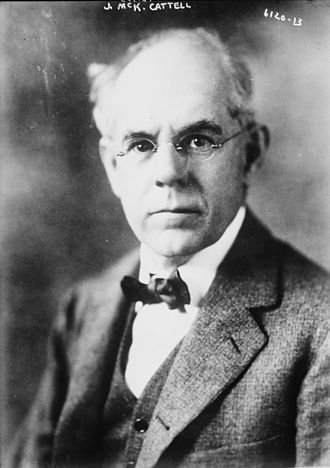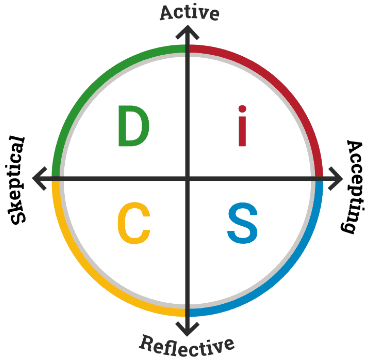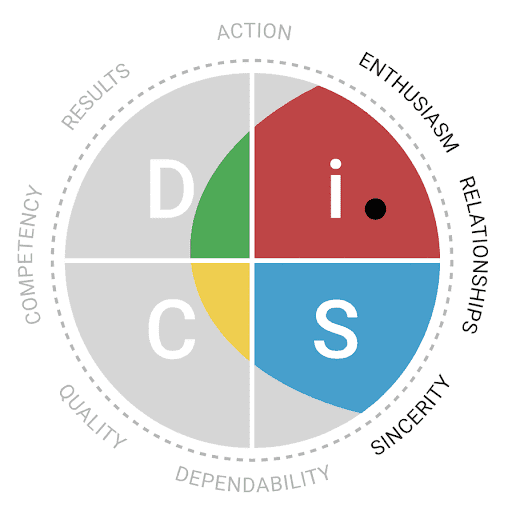How to use DiSC® to Improve Sales
Sales Techniques and DiSC®
DiSC® Sales is a behavioral model that teaches sales techniques based on the psychology of selling. DiSC Sales teach salespeople how to modify their communication style to match a customer’s preferred method of communication. It builds on decades of research on using psychology to better connect with customers.
The idea of identifying and teaching sales techniques wasn’t invented by Everything DiSC Sales. These techniques were first introduced for the first time in 1925 in E.K. Strong’s book The Psychology of Selling.

Strong wrote about various sales techniques, such as: using open-ended questions during discovery, explaining features & benefits, and objection handling.
This was the first time someone proposed that sales weren’t an innate ability but that better selling could be learned.
Here’s one of my favorite lines from the book:
“Selling in terms of permanent satisfaction, developing goodwill, and converting potential prospects into regular customers are all real psychological problems. They result when certain definite changes have taken place in prospects’ minds, so they come to think and feel in a new way.”
The Psychology of Selling; Edward Kellogg (E.K.) Strong
For most of my career, I worked in furniture retail sales. Throughout my career, I’ve held positions as a salesperson, a sales trainer, a sales manager, a general manager, and a market manager.
The one thing I found common within top sales teams was their desire to learn. The desire to improve how to connect, relate, and interact drove sales success.
So what have we learned in a hundred years? We’ve learned that Strong was right. Selling is psychological. In this article, I will explain how DiSC Sales can help teach principles first identified by Strong 100 years ago and why it’s valuable to invest in teaching how to use tools like DiSC Sales.
How the DiSC® Sales Assessment Works
The Everything DiSC Sales assessment is most known as a personality assessment. It is also called a DiSC Sales profile, DiSC Sales assessment, or, simply, DiSC. It uses William Moulton Marston’s DISC theory as its foundation.
DiSC is an acronym. Marston’s model found that everyone typically exhibits a primary behavioral tendency in one of the four areas:
- Dominance (D-Personality Type): Direct, firm, strong-willed
- Influence (i-Personality Type): Outgoing, enthusiastic, optimistic
- Conscientiousness (C-Personality Type): Analytical, reserved, precise
- Steadiness (S-Personality Type): Even-tempered, accommodating, patient
Let’s be clear; personalities are complex. While it’s true that DiSC will help anyone better understand their personality, it’s important to note that this tool only measures two primary behavioral traits to identify someone’s Behavioral Style. However, these two areas are often the most noticeable traits of anyone’s personality.
These two areas are Energy and Perception of our Environment.

Energy: Are you quick to action and prone to make gut decisions, or more cautious and want to move at a more methodical pace?
Perception of our environment: Do you challenge new information to make sure it’s correct? Do speak your mind even if you know it might affect someone. Or do you generally agree with what someone tells you and prefer to maintain a relationship over challenging someone about their belief?
These two behavioral dimensions are measured from a pool of over 100 questions on the DiSC Sales assessment. When you take the Sales assessment, you’ll be asked to rate yourself on a 5-point Likert scale. The assessment uses an advanced algorithmic question system called adaptive testing, so not every question is asked. Rather, the assessment will ask clarifying questions that relate to each style.
Once a person completes their DiSC Sales assessment, their DiSC Behavioral Styles are represented as a single dot on a map. A person’s preference towards their style is shown based on the dot’s location.
If a person’s dot is closer to the edge of the circle, they are more inclined with their DiSC Style, and if it’s closer to the center, they are less inclined to their style.



A person’s dots placement shows which priorities a person prefers. It also shows which priorities are harder for that person to choose based on how far away the dot is placed.
Learning your own style is the first step towards understanding how you communicate and, in turn, how to communicate better with others.
What to Expect from DiSC Sales Training
Everything DiSC® is a foundation for understanding people’s preferences. With DiSC, we learn what our behavioral tendencies are, how to identify other people’s styles, and how to communicate better with people that have different styles. This will lead to building rapport and higher closing rates.
In DiSC Sales training, you can expect to learn about DiSC Sales Strengths, Preferences, and Challenges. Additionally, the training will review how Salespeople can use DiSC to connect with customers more easily.
DiSC Sales Priorities & Preferences
Once a salesperson completes the DiSC® Sales Assessment their style is shown as a dot on a circumplex. For example, my dot and style are shown below:

I have the iS-style, a hybrid of the ‘i-Personality’ and ‘S-Personality’ styles. My DiSC Sales profile says:
“You’re probably a very warm and sociable salesperson who reaches out to customers with your welcoming, laid-back approach.”
While your dot location and your DiSC® style say a lot about you, your map shading is also important.
The eight words you see on the map are the possible Sales priorities someone can have. These are the primary areas that people focus their energy. The closer the shading is to the priority, the more of a focus it is.
As you can see by the shading, my priorities are:
- Enthusiasm
- Relationships
- Sincerity
Everyone has at least three priorities; some may have four or five. It’s important to understand that having five priorities is no better than having three and vice versa. It’s also important to understand that every DiSC® style is valuable, and a salesperson with any style can be successful.
The personalized report goes deeper into these areas, helping you understand how your priorities can shape your sales experience.
For example, one of my priorities is Developing Relationships. My profile says the following about this area:
“Brian, you probably view sales situations as opportunities to meet new people and share ideas. Furthermore, you may strive to create a bond with your customers by establishing trust and showing them respect. It’s important that your customers feel comfortable during sales situations, so you work hard to appear friendly and personable, developing a relationship that will help you both relax.”
In DiSC Sales Training, we go deep into these priorities, helping you to explore each one. Knowing what we place our focus on will help us to understand our Sales Strengths and Challenges as it relates to building relationships with customers and clients.

DiSC Sales: Strengths
Knowing your strengths and recognizing your challenges is paramount to being successful in any endeavor. Sales are no exception.
I’ve worked with salespeople that were strong at selling extended warranties or were great at closing at the moment with their customers. They knew they were strong in these areas, but getting them to understand why is the key to making them even more successful.
One of my strengths from my DiSC Sales profile results is Relationships, which was also one of my priorities. Here’s what my overview says about Relationships:
“You are probably upbeat and energetic, and you like to establish personal relationships with customers. You tend to come across as a friendly and enthusiastic person who is not just out to make a deal.”
Furthermore, it says:
- I take the time to connect with people.
- I empathize with people.
- I encourage customers to share their thoughts & feelings.
- I work to develop personal relationships with customers.
- I make it clear that I care about other people’s needs.
So what does this information tell me? Well, I’ve learned that I place an emphasis on developing relationships, and I take the time to connect with people. I know I put my energy into creating a warm, welcoming sales environment.
However, not everyone wants to have a warm, friendly salesperson. They may be looking for something else entirely in their sales experience. Analyzing my DiSC Sales Challenges will help me understand how I might miss opportunities to connect with my customers.

DiSC Sales: Challenges
Knowing my strengths is great, but I must also recognize what my challenges are as well. One of my challenges is listed as Action. Here’s how the action is a challenge of mine:
“You’re probably good at building personal relationships, but since you may not always emphasize the bottom line, more driven customers may lose interest. Furthermore, you probably aren’t very action-oriented, which could cause more fast-paced customers to grow impatient.”
My personalized report goes deeper and breaks down the specifics for me.
- I sometimes take the process too slow.
- I can come across as indecisive.
- At times, I sugarcoat unpleasant truths.
- I may neglect to control the discussion or keep it on track.
- I sometimes feel overwhelmed when customers are aggressive or demanding.
So what does this information do for me? It allows me to take an objective look at how I interact with my customers. This information will guide me to communicate with them more effectively, in turn driving more closings.
For example, I know now from my DiSC Sales Strengths that I focus on building relationships with my customers and try to show them my sincerity. However, customers may see me as indecisive. I might also become overwhelmed by more demanding customers.

